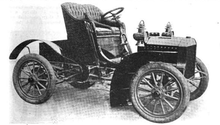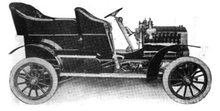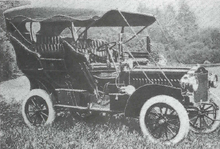Lambert Automobile Company
The Lambert Automobile Company was an American automobile manufacturer that built cars and trucks in Anderson, Indiana from 1905 to 1917. It emerged from the automotive parts production of the Buckeye Manufacturing Company , which is also part of the Lambert family .
description
In the early Lambert automobiles, the engine often changed its installation location: first the engines were installed at the rear, then in the middle, then at the very front and finally back again. The engines of the early vehicles originated in the Lambert Gas and Gasoline Engine Company ; later they came from other suppliers.
The Lambert chassis had three-point wheel suspensions that limited the spring travel required by the uneven road surface. This type of suspension also reduced wear and tear. Other manufacturers had simpler chassis. Some Lambert automobiles had cardan shafts, but most had chain drives to the rear axle.
The Lambert chassis with friction disc drive was the basis on which the automobiles and trucks were built from 1906 to 1916. The engines were equipped with hardened camshafts. The cams were designed to be slightly convex and served hardened cylinder rollers that sat in rocking forks and acted on square rocker arms, which in turn moved the valves.
The Lambert boxer engine had some details that were not common in gasoline engines at the time. For example, the oil supply had to be precisely adjusted with various adjusting screws so that each crank and the crankshaft ends were supplied with the appropriate amount of oil. All cranks had cheeks made of solid discs and the crankshaft bearings were made of bronze.
A Lambert was runner-up in the 1905 Chicago to St. Paul auto race . 53 automobiles were registered and the Lambert was the only gasoline-powered car to make the full race distance. The success of the 16-bhp Lambert against other 40-bhp automobiles is attributed to the friction disc drive.
Some Lambert models are described below:
Car models
Model overview
| model | Construction period | cylinder | power | Wheelbase (mm) | Superstructures | Brief description | photo |
|---|---|---|---|---|---|---|---|
| A. | 1906 | 2 boxers | 16 bhp (11.8 kW) | 1981 | Runabout 2 seats | The Lambert Model A Runabout had a wheelbase of 1981 mm, a track width of 1422 mm and 89 mm wide 30 ″ wheels. It weighed 815 kg and cost US $ 900 including two oil lamps, mats, horn and tools. It had a two-cylinder boxer engine with a capacity of 3707 cm³ installed at the rear, which transmitted its power to the rear wheels via friction discs and side chains. The Model A Runabout was the cheapest model in the Lambert range in 1906. The boxer engine in the rear was cheap to manufacture and also added weight to the drive wheels. |
|
| 4th | 1906 | 2 boxers | 16 bhp (11.8 kW) | 2388 | Touring car 5 seats | Model 4 from 1906 had a removable tonneau structure with five seats. The wheelbase was 2388 mm, the track width 1422 mm. The wheels were 30 ″ in diameter and 89 mm wide. The vehicle weighed 906 kg and cost US $ 1050, including two oil lamps, mats, horn and tools. It had a two-cylinder boxer engine with a capacity of 3707 cm³ installed at the very front, which transmitted its power to the rear wheels via friction discs and side chains. | |
| 5 | 1906 | 2 boxers | 16 bhp (11.8 kW) | 2388 | Touring car 5 seats | Model 5 from 1906 was the same as Model 4, but weighed 951 kg and cost US $ 1200. | |
| 6th | 1906 | 2 boxers | 18 bhp (13.2 kW) | 2134 | Touring car 5 seats | ||
| 7th | 1906 | 4 row | 34 bhp (25 kW) | 2489 | Touring car 5 seats | Model 7 from 1906 had a touring car body with side entry and five seats. In terms of wheelbase and track width, it corresponded to models 4 and 5, but had a four-cylinder engine with 7414 cm³, weighed 1019 kg and cost US $ 2000. The structure corresponded to the model 6. | |
| 8th | 1906 | 4 row | 34 bhp (25 kW) | 2489 | Touring car 5 seats | Model 8 from 1906 had a touring car body with side entry and five seats. The wheelbase was 2489 mm, the track width 1422 mm. The wheels were 34 ″ in diameter and 114 mm wide. The vehicle weighed 1,042 kg and cost US $ 3,000, including two oil lamps, mats, horn and tools. It had a four-cylinder in-line engine with a capacity of 5212 cm³, which transmitted its power to the rear wheels via friction discs and side chains. It had side doors for the rear seat passengers and the driver and was built for extended travel. | |
| L. | 1907 | 2 boxers | 16 bhp (11.8 kW) | 2388 | Touring car 5 seats | ||
| J | 1907 | 4 row | 40 bhp (29 kW) | 2667 | Runabout 2 seats | ||
| G | 1907 | 4 row | 40 bhp (29 kW) | 2692 | Touring car 7 seats | ||
| F. | 1907 | 4 row | 40 bhp (29 kW) | 2692 | Touring car 5 seats | The Model F from 1907 had a touring car body with side entry and five seats. The wheelbase was 2692 mm, the track width 1422 mm. The wheels were 34 ″ in diameter and 114 mm wide. The vehicle weighed 1,314 kg and cost US $ 3,000 including two oil lamps, mats, horn, alternator, JONES speedometer and tools. It had a four-cylinder in-line engine with a capacity of 5212 cm³, which produced 40 bhp (29 kW) and transmitted its power to the rear wheels via friction discs and side chains. It had side doors for the rear seat passengers and the driver and was built for extended travel. | |
| H | 1907 | 4 row | 40 bhp (29 kW) | 2692 | Touring car 5 seats | ||
| 18th | 1908 | 2 boxers | 18 bhp (13.2 kW) | 2413 | Runabout 2 seats | The 1908 Model 18 Runabout had two seats. The wheelbase was 2413 mm, the track width 1422 mm. The wheels were 30 ″ in diameter and 89 mm wide. The vehicle weighed 1042 kg and cost US $ 800, including two oil lamps, mats, horn and tools. It had a two-cylinder boxer engine with a capacity of 3707 cm³ installed above the rear axle, which transmitted its power to the rear wheels via friction discs and side chains. | |
| S. | 1908 | 2 boxers | 24 bhp (17.6 kW) | 2388 | Touring car 5 seats | ||
| Shaft Drive | 1908 | 4 row | 40 bhp (29 kW) | 2667 | Touring car 5 seats | ||
| Friction Drive | 1908 | 4 row | 40 bhp (29 kW) | 2692 | Touring car 7 seats | ||
| A1 | 1909 | 2 boxers | 20 bhp (14.7 kW) | 2413 | Roadster 3 seats, Surrey 4 seats | ||
| 27 | 1909 | 4 row | 28 bhp (20.6 kW) | 2794 | Roadster 4 seats | ||
| 30th | 1909 | 4 row | 28 bhp (20.6 kW) | 2794 | Touring car 5 seats | Model 30 from 1909 had a removable tonneau structure with five seats. The wheelbase was 2794 mm, the track width 1422 mm. The wheels were 34 ″ in diameter and 114 mm wide. The vehicle weighed 1,314 kg and cost US $ 1,250, including two oil lamps, mats, horn and tools. It had a four-cylinder in-line engine with 28 bhp (21 kW) installed at the front, which transmitted its power to the rear wheels via friction disks and side chains. | |
| B2 | 1909 | 4 row | 40 bhp (29 kW) | 2972 | Touring car 5/7 seats | ||
| 17th | 1910 | 4 row | 28 bhp (20.6 kW) | 2540 | Runabout 2 seats | ||
| 21st | 1910 | 4 row | 28 bhp (20.6 kW) | 2540 | Surrey 4 seats | ||
| 28 | 1910 | 4 row | 35 bhp (25.7 kW) | 2667 | Tonneau 4 seats | ||
| 36 | 1910 | 4 row | 35 bhp (25.7 kW) | 2794 | Touring car 5 seats | The 1910 model 36 had the same chassis and structure as the 30 model, but with the smaller 30 ″ wheels that were 89 mm wide. It weighed 1,087 kg and cost US $ 1,275, including two oil lamps, mats, horn and tools. It had a four-cylinder in-line engine with 35 bhp (26 kW) power installed at the front, which transmitted its power to the rear wheels via friction discs and side chains. | |
| 47 | 1910 | 4 row | 49 bhp (36 kW) | 2921 | Touring car 5 seats | ||
| 44 | 1911 | 4 row | 35 bhp (25.7 kW) | 2540 | Runabout 2 seats | ||
| 55 | 1911 | 4 row | 35 bhp (25.7 kW) | 2540 | Surrey 4 seats | ||
| 77 | 1911 | 4 row | 35 bhp (25.7 kW) | 2718 | Tonneau 4 seats | ||
| 88 | 1911 | 4 row | 35 bhp (25.7 kW) | 2845 | Touring car 5 seats | ||
| 101 | 1911 | 4 row | 40 bhp (29 kW) | 2845 | Torpedo 4 seats | ||
| 100 | 1911 | 4 row | 40 bhp (20.6 kW) | 2972 | Touring car 5 seats | ||
| 66 | 1912 | 4 row | 35 bhp (25.7 kW) | 2845 | Touring car 4/5 seats | ||
| 99-C | 1912 | 4 row | 40 bhp (29 kW) | 2845 | Roadster 4 seats | The 1912 model 99-C had a roadster body with two seats. The wheelbase was 2972 mm, the track width 1422 mm. The wheels were 34 ″ in diameter and 114 mm wide. The vehicle weighed 1450 kg and cost US $ 1250, including two oil lamps, mats, horn and tools. It had a four-cylinder in-line engine with 40 bhp (29 kW) installed at the front, which transmitted its power to the rear wheels via friction discs and side chains. | |
| 99 | 1912-1913 | 4 row | 40 bhp (29 kW) | 2972 | Torpedo 4 seats, touring car 5 seats | ||
| 9 | 1913 | 4 row | 20 bhp (14.7 kW) | 2591 | Roadster 2 seats | ||
| 10 | 1913 | 4 row | 20 bhp (14.7 kW) | 2718 | Touring car 5 seats | ||
| 40 | 1913 | 3 row | 16.8 bhp (12.4 kW) | 2845 | Touring car 5 seats | ||
| 50 | 1913 | 4 row | 40 bhp (29 kW) | 2845 | Touring car 5 seats | ||
| 46-C | 1914 | 4 row | 23 bhp (16.9 kW) | 2845 | Touring car 4 seats | The 1914 model 46-C had a touring car body with four seats. The wheelbase was 2845 mm, the track width 1422 mm. The wheels were 30 ″ in diameter and 89 mm wide. The vehicle weighed 1133 kg and cost US $ 1200, including two oil lamps, mats, horn and tools. It had a four-cylinder in-line engine with 23 bhp (17 kW) installed at the front, which transmitted its power to the rear wheels via friction discs and side chains. | |
| 60-C | 1914 | 4 row | 27 bhp (19.9 kW) | 2921 | Touring car 5 seats | ||
| 48-C | 1915 | 4 row | 23 bhp (16.9 kW) | 2845 | Touring car 5 seats | The model 48-C from 1915 was the successor to the 46-C and corresponded to it in the essential values. | |
| 68-C | 1915 | 4 row | 27 bhp (19.9 kW) | 2921 | Roadster 2 seats, touring car 5 seats | ||
| 76 | 1916 | 4 row | 23 bhp (16.9 kW) | 2845 | Roadster 2 seats, touring car 5 seats | ||
| 90 | 1917 | 4 row | 35 bhp (25.7 kW) | 2921 | Touring car 5 seats |
Commercial vehicle production
Lambert was already producing isolated commercial vehicles at Buckeye Manufacturing in the 1890s and later also at the Union plant in Union City (Indiana) ; these vehicles (mostly passenger cars) were assembled from components obtained from Buckeye Manufacturing . This plant had been built with funding from the city and was abandoned in 1905 with the establishment of the Lambert Automobile Company.
Regulated commercial vehicle production began in 1906 in the new facilities in Anderson. The vehicles of the first generation, built until 1911, followed the passenger cars in terms of design. they too had the tried and tested two-cylinder boxer engines. The second generation was introduced in 1912. Four-cylinder engines from Buda , Continental , Davis, Rutenber and Trebert were now used. The company remained true to the drive concept with friction gears and double chain drives to the very end. Lambert commercial vehicles were built until 1918, a year longer than passenger cars.
Truck models
Model a
The truck model A had a cab with 2 seats. The wheelbase was 2438 mm, the track width 1422 mm. The rear wheels were 32 ″ in diameter and 102 mm wide; the front wheels were 89 mm wide. All tires came from Firestone. The vehicle weighed 1359 kg empty, had 1.4 tons. Payload and cost US $ 2000, -. It had a two-cylinder boxer engine with a displacement of 4672 cc installed behind the driver's seat, which transmitted its power to the rear wheels via friction disks and side chains. Flatbed and bonnet were delivered at an additional cost.
Model B.
The truck model B weighed 1087 kg empty and the payload was 680 kg. It cost US $ 1500. The two-cylinder boxer engine with a displacement of 4170 cm³ was also placed directly behind the driver and also drove the rear wheels via a friction disc transmission. Otherwise, his data corresponded to model A.
literature
- Anderson Morning Herald Archives , Anderson, Indiana
- Biography of John W. Lambert written by his son on January 25, 1935 - obtained from the Detroit Public Library, National Automotive History Collection.
- Forkner, John L .: History of Madison County, Indiana , The Lewis Publishing Company, York and Chicago (1914)
- The Horseless Age: The Automobile Trade Magazine , The Horseless Age Company, (1902)
- Scott, Bailey L .: Historic Discovery: 1891 Lambert, New Claim for America's First Car , Antique Automobile magazine, Issue 24, No. 5, October / November 1960.
- Wise, David Burgess: The New Illustrated Encyclopedia of Automobiles , ISBN 0-7858-1106-0 .
- Dittlinger, Esther et al .: Anderson: A Pictorial History , G. Bradley Publishing, (1990), ISBN 0943963168 .
- Georgano, GN: The Beaulieu Encyclopedia of the Automobile , Taylor & Francis, (2000), ISBN 1-5795829-3-1 .
- Huffman, Wallace Spencer: Indiana's Place in Automobile History in Indiana History Bulletin , Issue 44, No. 2, Indiana Historical Bureau, Indianapolis (February 1967)
- Huhti, Thomas: The Great Indiana Touring Book: 20 Spectacular Auto Tours , Big Earth Publishing (2002), ISBN 1-9315990-9-2 .
- James, Wanda: Driving from Japan , McFarland (2005), ISBN 0-786417-3-4X .
- Madden, WC: Haynes-Apperson and America's First Practical Automobile: A History , McFarland (2003), ISBN 0-7864139-7-2 .
- Scharchburg, Richard P .: Carriages Without Horses: J. Frank Duryea and the Birth of the American Automobile Industry , Society of American Engineers, (1993), ISBN 1-5609138-0-0 .
- Mroz, Albert: Illustrated Encyclopedia of American Trucks and Commercial Vehicles ; Krause Publications, Iola WI (1996); ISBN 0-87341-368-7 ; ISBN 978-0-87341-368-8 .
Web links
Individual evidence
- ^ David Burgess Wise: The New Illustrated Encyclopedia of Automobiles . Greenwich Editions, London 2004, ISBN 978-0-86288-258-7 , pp. 348 (English).
- ↑ a b c d e f g h i j k l Dolnar, Hugh: The Lambert, 1906 Line of Automobiles , Automobile Trade Journal, Chilton Company, January 10, 1906
- ↑ a b c d e f g h i j Kimes, Beverly Rae, Standard Catalog of American Cars, 1805–1942 , Krause Publications, Iola (1996), ISBN 0-8734142-8-4
- ↑ Anderson Morning Herald , July 6, 1905
- ^ Kimes, Beverly Rae, Standard Catalog of American Cars, 1805-1942 (1996), p. 1486
- ^ A b Mroz, Albert: Illustrated Encyclopedia of American Trucks and Commercial Vehicles (1996), p. 241













